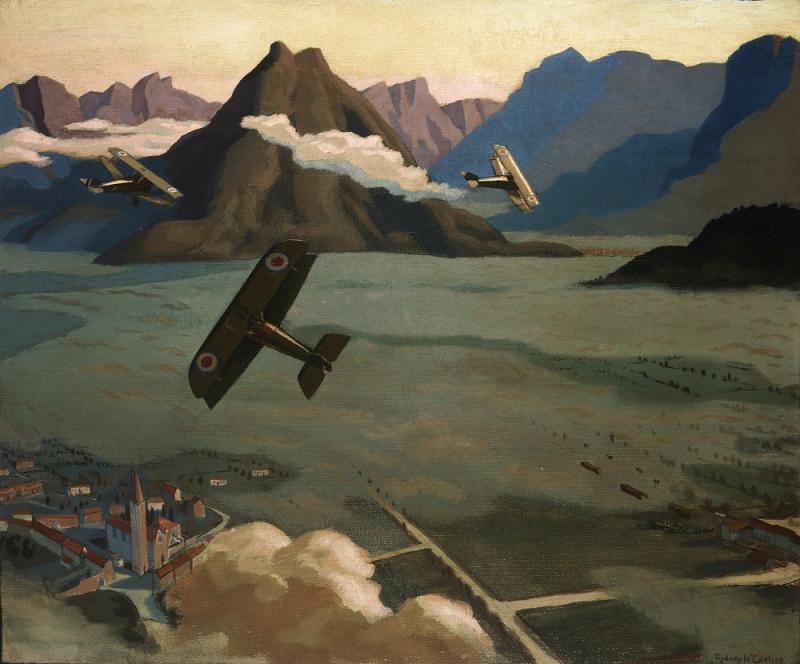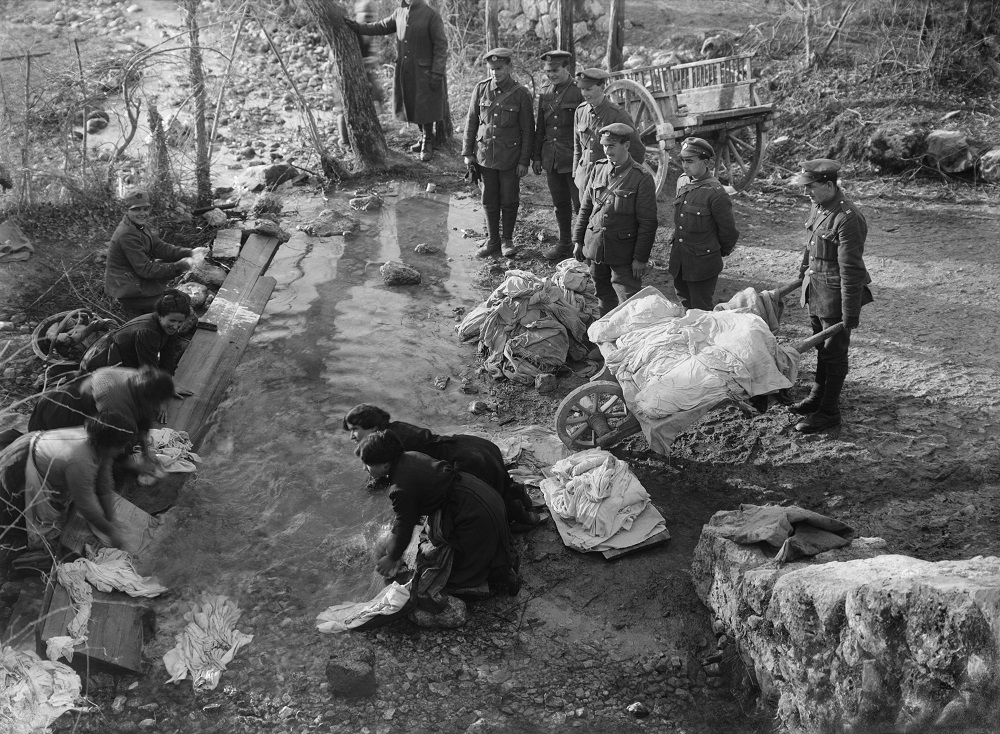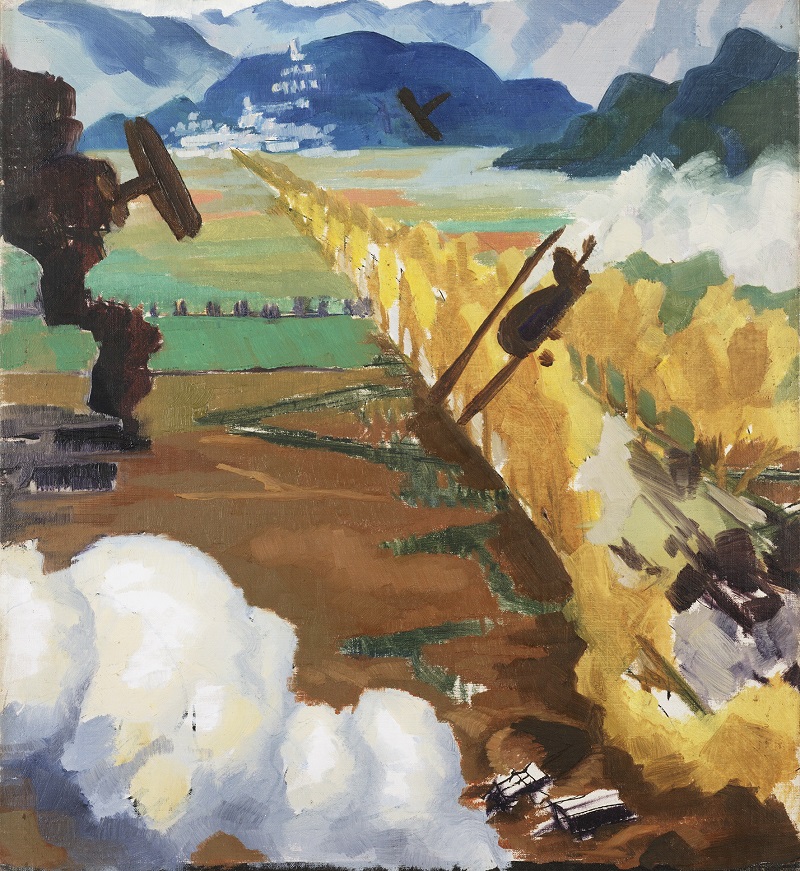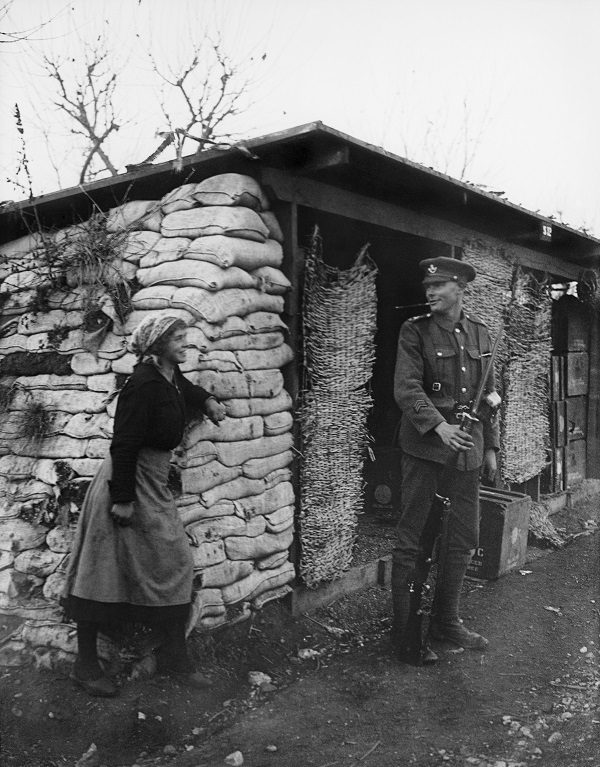War in the Sunshine, Estorick Collection | reviews, news & interviews
War in the Sunshine, Estorick Collection
War in the Sunshine, Estorick Collection
Rediscovered paintings and photographs show wartorn Italy through British eyes

North London’s much loved Estorick Collection is reopening its doors after a five-month spruce up. The Georgian listed building that houses a 120-piece collection of modern Italian art now boasts a new glass conservatory, opened out entrance hall and "daylight-enhanced" gallery spaces. It all bodes well, even if the reliance on a period of prolonged British sunshine to complete the effect feels a touch optimistic right now. Here’s hoping.
The Collection’s return is marked by a temporary exhibition surveying a seldom highlighted episode from World War One. From 1917-18, thousands of British troops were dispatched to Italy to join the resistance against advancing Austro-Hungarian forces. It was a vital intervention, but one that’s still relatively unknown. Here works by three Brits, painter Sydney Carline and photographers Ernest Brooks and William Joseph Brunell, offer an eye-opening record of conflict in mountainous terrain that must have felt so very far away from the flatlands of Flanders or the trenches of France. (Pictured below: Men of the Royal Engineers watch as their clothes are washed in a stream by Italian peasant women, November-December 1917, courtesy: Imperal War Museum)
Sydney Carline first served his country as a pilot. He had already flown on secret reconnaissance missions in Italy in 1918 before being appointed an official war artist. His primary role was to record the heroic deeds of the newly formed RAF and their jewel in the crown – the Sopwith Camel. Military higher-ups must have been delighted with showpiece paintings like British Scouts leaving their Aerodrome on Patrol, 1918 (main picture).
 The reality was that aircraft like these were perilously rickety, but in Carline’s large canvases clusters of them soar with ease above the clouds. Carline makes full use of the stunning Italian mountains as a dramatic backdrop to his carefully staged scenes of aerial theatre. Pink and yellow sun rays catch a distant bi-plane wing as it veers away towards the horizon. It’s hard to think of a better advert for the Air Force’s new tech than these masterclasses in military visual hagiography. They wouldn’t be out of place on a billboard promoting Farnborough Air Show.
The reality was that aircraft like these were perilously rickety, but in Carline’s large canvases clusters of them soar with ease above the clouds. Carline makes full use of the stunning Italian mountains as a dramatic backdrop to his carefully staged scenes of aerial theatre. Pink and yellow sun rays catch a distant bi-plane wing as it veers away towards the horizon. It’s hard to think of a better advert for the Air Force’s new tech than these masterclasses in military visual hagiography. They wouldn’t be out of place on a billboard promoting Farnborough Air Show.
Half the size but with infinite times the raw artistic power is a show-stopping depiction of a Sopwith Camel patrol attacking an Austrian aerodrome near the provincial Italian town of Sacile (pictured below right) – a raid that the artist himself took part in. Gone is the serenity of calm above the clouds and refined painterly finish. We’re plunged right into the action of an airstrike at full throttle. Just a few swift brush strokes define a plane swooping low, another pulls up out of billowing smoke from a burning building. Lines of trees so often a feature of an Italian pastoral idyll here tear through the scene with a sweeping destructive energy. Their distinctive tawny yellow colour here makes them look more like exploding bombs than part of the natural landscape. With paint on wooden board alone, Carline recreates a sequence of aerial warfare as visceral and immersive as any in Apocalypse Now.
 Also on display are studies of air attacks sketched out frenetically in pencil or pen. There’s a sense Carline is constantly playing around with which angles and views best capture this new way of seeing the world and a mode of combat still in its infancy. Carline reportedly tried dashing off drawings from the cockpit while flying the plane himself with his knees, or making watercolours from the rear observer’s seat only to find that the water froze. He eventually settled on a balance of safety and immediacy, getting down his impressions within half an hour of landing.
Also on display are studies of air attacks sketched out frenetically in pencil or pen. There’s a sense Carline is constantly playing around with which angles and views best capture this new way of seeing the world and a mode of combat still in its infancy. Carline reportedly tried dashing off drawings from the cockpit while flying the plane himself with his knees, or making watercolours from the rear observer’s seat only to find that the water froze. He eventually settled on a balance of safety and immediacy, getting down his impressions within half an hour of landing.
Away from the thick of battle Carline was clearly captivated by the beauty of a strange land he had never been to before. One watercolour of a sunset over the Italian alps glowing with warm Turneresque reds and yellows has a vibrancy that feels like it was painted by somebody experiencing it for the first time.
Like Carline, British photographer Ernest Brooks was a former soldier. He was one of the first to be offered an official position as a British military war photographer, well known for his tough, even reckless attitude on the front line. A wall of his photographs show a diligent thoroughness for following life for the Tommies in the Italian mountains, with plenty of troops marching down hillsides and portraits of commanding officers. Brooks reportedly didn’t have much truck with the locals. His images of Italians often depict them dutifully carrying out subservient duties, such as women washing clothes or plucking chickens for British troops.
Brooks also had a penchant for showing off the Sopwith Camel. Rows of them get a photograph all to themselves. Hanging just above the photos in this gallery is a practically full-scale sculpture of a bi-plane made by contemporary artist Keith Roberts, constructed out of cardboard, thin parcel paper and bamboo lashed together with string. Its size may be imposing as it looms overs us, but the fact it looks like it might all fall apart in a strong gust of wind makes it a fitting tribute to the Great War’s most famous aircraft.
 In contrast, William Brunell was a civilian who had little clue about military life before heading out to the Italian front. There’s an outsider’s curiosity about his photographs which include carefully composed images of ruined village buildings and soldiers posing in the landscape. One shot of Italian troops and British officers altogether in in a snowy forest has all the hallmarks of a Christmas family snap – until you see the honking great field gun barrel they’re leaning on. Brunell is deeply inquisitive about the lives of the residents. His photographs of women serving in the British army are far from a perfunctory record; they are remarkably sensitive portraits with a deliberate intention of capturing personality and character in a single shot (pictured left: William Joseph Brunell, British sentry and Italian peasant woman, November 1918).
In contrast, William Brunell was a civilian who had little clue about military life before heading out to the Italian front. There’s an outsider’s curiosity about his photographs which include carefully composed images of ruined village buildings and soldiers posing in the landscape. One shot of Italian troops and British officers altogether in in a snowy forest has all the hallmarks of a Christmas family snap – until you see the honking great field gun barrel they’re leaning on. Brunell is deeply inquisitive about the lives of the residents. His photographs of women serving in the British army are far from a perfunctory record; they are remarkably sensitive portraits with a deliberate intention of capturing personality and character in a single shot (pictured left: William Joseph Brunell, British sentry and Italian peasant woman, November 1918).
This show certainly makes for a fascinating document of an overlooked part of British involvement in the Great War, but it’s the range of ideas for capturing a new type of conflict from artists in unfamiliar territory that stays with you. To even out the pulse rate it’s a good idea to head upstairs for a look around the permanent collection, and in particular an entire room’s worth of drawings by the Bolognese master of still life, Giorgio Morandi.
- War in the Sunshine: The British in Italy 1917-1918 at the Estorick Collection until 19 March
- Read more visual arts reviews on theartsdesk
rating
Share this article
The future of Arts Journalism
You can stop theartsdesk.com closing!
We urgently need financing to survive. Our fundraising drive has thus far raised £49,000 but we need to reach £100,000 or we will be forced to close. Please contribute here: https://gofund.me/c3f6033d
And if you can forward this information to anyone who might assist, we’d be grateful.

Subscribe to theartsdesk.com
Thank you for continuing to read our work on theartsdesk.com. For unlimited access to every article in its entirety, including our archive of more than 15,000 pieces, we're asking for £5 per month or £40 per year. We feel it's a very good deal, and hope you do too.
To take a subscription now simply click here.
And if you're looking for that extra gift for a friend or family member, why not treat them to a theartsdesk.com gift subscription?
more Visual arts
 'We are bowled over!' Thank you for your messages of love and support
Much-appreciated words of commendation from readers and the cultural community
'We are bowled over!' Thank you for your messages of love and support
Much-appreciated words of commendation from readers and the cultural community
 Lee Miller, Tate Britain review - an extraordinary career that remains an enigma
Fashion photographer, artist or war reporter; will the real Lee Miller please step forward?
Lee Miller, Tate Britain review - an extraordinary career that remains an enigma
Fashion photographer, artist or war reporter; will the real Lee Miller please step forward?
 Kerry James Marshall: The Histories, Royal Academy review - a triumphant celebration of blackness
Room after room of glorious paintings
Kerry James Marshall: The Histories, Royal Academy review - a triumphant celebration of blackness
Room after room of glorious paintings
 Folkestone Triennial 2025 - landscape, seascape, art lovers' escape
Locally rooted festival brings home many but not all global concerns
Folkestone Triennial 2025 - landscape, seascape, art lovers' escape
Locally rooted festival brings home many but not all global concerns
 Sir Brian Clarke (1953-2025) - a personal tribute
Remembering an artist with a gift for the transcendent
Sir Brian Clarke (1953-2025) - a personal tribute
Remembering an artist with a gift for the transcendent
 Emily Kam Kngwarray, Tate Modern review - glimpses of another world
Pictures that are an affirmation of belonging
Emily Kam Kngwarray, Tate Modern review - glimpses of another world
Pictures that are an affirmation of belonging
 Kiefer / Van Gogh, Royal Academy review - a pairing of opposites
Small scale intensity meets large scale melodrama
Kiefer / Van Gogh, Royal Academy review - a pairing of opposites
Small scale intensity meets large scale melodrama
 Jenny Saville: The Anatomy of Painting, National Portrait Gallery review - a protégé losing her way
A brilliant painter in search of a worthwhile subject
Jenny Saville: The Anatomy of Painting, National Portrait Gallery review - a protégé losing her way
A brilliant painter in search of a worthwhile subject
 Abstract Erotic, Courtauld Gallery review - sculpture that is sensuous, funny and subversive
Testing the boundaries of good taste, and winning
Abstract Erotic, Courtauld Gallery review - sculpture that is sensuous, funny and subversive
Testing the boundaries of good taste, and winning
 Edward Burra, Tate Britain review - watercolour made mainstream
Social satire with a nasty bite
Edward Burra, Tate Britain review - watercolour made mainstream
Social satire with a nasty bite
 Ithell Colquhoun, Tate Britain review - revelations of a weird and wonderful world
Emanations from the unconscious
Ithell Colquhoun, Tate Britain review - revelations of a weird and wonderful world
Emanations from the unconscious
 Rachel Jones: Gated Canyons, Dulwich Picture Gallery review - teeth with a real bite
Mouths have never looked so good
Rachel Jones: Gated Canyons, Dulwich Picture Gallery review - teeth with a real bite
Mouths have never looked so good

Add comment